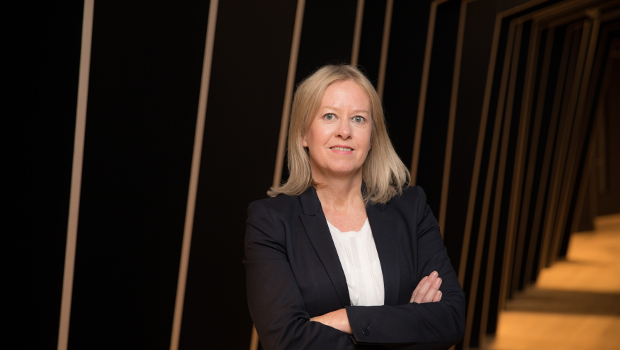
Collaboration: what does good look like?
We are often told that a company’s most important resource is its staff and that collaboration is where real value comes from. But despite the ubiquity of the tools and platforms to facilitate it, not everyone knows how best to make good collaboration happen.
Meanwhile, the way in which large companies are organised is changing and there is growing pressure on staff to make use of tools like Slack, Skype, Microsoft Teams, Trello and more.
“The issue of collaboration is a really pressing one for many larger companies because it’s becoming more common to have at least part of your workforce operating remotely from your workplace,” said Catherine Doyle, regional sales director for enterprise for Ireland with Dell EMC.
“There are many benefits to this, but it also poses the question of how do you create a really good collaborative culture for people who are in the same team but not located in the same place? We have come to the conclusion that at least some of the time, you need to be able to see your team mates.”

“You need to be able to see their facial expressions. As a result of this, how we leverage video is becoming hugely important to us, particularly on desktop.”
Conversation flow
This is an interesting development. Video conferencing has been around for many years but it is only as broadband speeds have climbed that it has become really viable. After all, for video to work as a collaboration medium, everyone on the call has to have enough bandwidth to support a high-resolution moving picture, whether they are in an office or using a mobile connection.
“We tried to do this in the past, and even as recently as two years ago, it didn’t really work. Okay, you could place a call but the image quality frequently dropped and you ended up looking at pixelated images,” said Doyle.
“The result was that the flow of the conversation halted while you wait for a better connection or someone dials in again.”
This development is fuelling a new era of video-based collaboration tools, according to Doyle, who said that within Dell EMC these tools are being used more frequently.

“We use Skype and VMware uses Zoom, and it’s become a regular feature of how we work. This is really important because it helps grow and promote the company’s internal collaboration culture. Ultimately you do need to see each other physically from time to time but video can be a really powerful tool when the occasion doesn’t merit actually travelling to see people.”
“To be clear though, I believe the ultimate collaboration will always be sitting in a room with people, talking face to face, and for some projects you just need to do that. But for situations when you can’t get together, because some people are working remotely or in different countries and time zones, then video is the next best thing.”
Ask most executives more than a few years into their career whether they enjoy getting up for early morning flights to visit offices in other locations, and the answer will usually be no. Collaboration tools are not just cheaper, they are also more convenient and friendly to the work/life balance.
“By the time you fly everyone around, factoring in the time and the cost, not to mention the goodwill of staff, and yes, video starts to seem like a good idea,” said Doyle.
Talent issues
A further benefit of using collaboration tools is that for some jobs, expertise is in low supply. Being able to access technical know-how without having to physically get the experts who possess it in the same room at the same time can have real value.
“We’ve all seen the changes in work practices over the last few years. It’s now much more common for people to work from different locations than it used to be, working across multiple locations and using multiple devices,” said Shirley Finnerty, business group lead at Microsoft Ireland.

“There are sometimes also up to five generations of people working in the same workplaces, with millennials expected to account for around 50% of the workforce by 2020. These demographic changes are bringing with them new expectations from employees.”
“There’s been a shift away from doing routine tasks to a style of work that is very collaborative and that involves teams thinking creatively. In that respect, our customers’ needs are evolving and in terms of the solutions we offer, this is one area that really needs to be thought about by customers,” she said.
Having the right kind of collaborative culture is as much about retaining good employees as it is about attracting new people into the fold. However, if senior management don’t understand the importance of this and adopt it into the way they think about the workplace, it places the organisation on the back foot.
“For example, millennials expect to work in open and inclusive workspaces and want employers to rethink how they manage the workplace in terms of communication and collaboration. If they don’t find that, they’ll move,” she said.
“If the senior management isn’t adopting this new approach and providing employees with the tools and solutions that enable them to work in these different ways, not only will the company have issues attracting and keeping staff, you won’t see the kind of digital transformation across the organisation that many companies are looking for.”
Joined-up
A key part of the Microsoft’s collaboration offering is the Teams package, built into Office 365. A key component of the company’s thrust in this area is that using joined up software from the same supplier means that crucial technologies concerning security play well together.
According to Finnerty, it is Microsoft’s job to be able to supply the right tools for its customers to be able to meet these demands but there also needs to be an understanding from the leadership team in the customer’s organisation to support the initiative. Without this, the culture required to get the most from collaboration won’t form.
“That means being willing to engage with employees who want to work from home one day a week, and providing the tools necessary to be able to do a full day’s work remotely, securely accessing corporate data to do their job,” she said.
“And this is only going to become more
important. Younger people work this way intuitively, but they won’t stay young
for ever. They’ll age into positions of responsibility and eventually
leadership, bringing these ideas with them.”
“We’re seeing it already in Ireland, some companies
are embracing this whole heartedly and some are a little further behind in the
journey and are still considering how they’re going to evolve their workplace
in line with the expectations of employees and management.”
Visual aids
Culture is also at the heart of new efforts to better understand how collaboration can work. Justin Gallagher is head of product management and one of the founders of Trello, a New York-based software offering that places visual aids at the heart of the collaboration process.

“Trello is a visual collaboration tool that helps people literally get on the same page with each other, collaborate on things and work together in a way that’s simple and flexible and even occasionally fun,’ said Gallagher.
“When we started working on it in 2011, the problem we were seeing was that companies with traditional project management tools would have access to all the information they needed in the form of tasks, logs and tickets but when it came down to answering simple questions like ‘who’s working on what?’ and ‘what stage is this project at?’ it was proving quite difficult to get that information quickly.”
Often Gallagher’s team found that even if users could get those answers, it required a high level of proficiency with the tool to do it.
“At the same time, we noticed that people were managing this deficiency by literally putting up sticky notes on a whiteboard and keeping track of things that way. This was at a time when the business world was seeing the rise of distributed and remote teams and it just seemed ridiculous,” he said.
The solution the team came up with was a tool that aims to be as simple to use as the sticky notes on the whiteboard, but which can answer high level questions that are conventionally hard to get out of such tools.
“We needed it to be visual and fun and customisable enough that people would actually want to use it. We wanted it to be usable first by small teams and then by entire companies but not have it suffer from bloat and feature load,” said Gallagher.
“We wanted it to be simple and elegant and decided we’d grow it not by loading it with features that might help initially sell it to senior management but rather make it usable enough that their staff would actually seek it out by reputation, so that it had fans.”
Today Trello is used as a collaboration tool by the likes of Adobe, Kickstarter, Fender and Google and the company claims 35 million users around the world.
“If you look at the progression of consumer apps such as social media tools and so on, you see that over time they’ve become more and more visual and intuitive in how they work. Some of them, such as Pinterest and Instagram, are literally just pictures and video,” said Gallagher.
Meanwhile Trello also seeks to keep pace with the changing way in which teams communicate as well as work.
“For example, 10 years ago people weren’t chatting on instant messaging software at work but they do today. Younger people in particular, as they make their way into the workplace, are bringing a confidence and preference for visual tools and collaboration tools that just work,” he said.
Collaboration hubs
According to Stuart Templeton, head of UK for Slack, collaboration technology such as that offered by his company increases organisational flexibility and allows modern workforces to become more agile.
“The way we work with each other is fundamentally changing. Efficient and effective collaboration between teams has become an essential business priority and better alignment between people and teams helps unlock greater productivity — and this is where collaboration hubs come into play,” he said.
Slack terms what it offers as ‘collaboration hubs,’ to differentiate it from offerings which merely offer instant messaging and group work on files.
“In collaboration hubs like Slack communication happens in channels, which are virtual spaces grouped around a particular project or topic. In a channel, every member of a team has access to the same information at the same time. This level of transparency creates a knowledge repository that allows new team members to get up to speed quickly,” said Templeton.
The idea is that software like Slack brings the right people together with the right information and allows them to find what they need faster and easier.
“To date, email has played a big part in office communication but its individual-first approach to knowledge sharing is no longer fit-for-purpose in modern organisations. The silos of information created by email need to be broken up.”
Templeton believes that the future of workplace collaboration is channel-based and that by 2025 channels will replace email as the primary means of communication at work.
“Giving employees access to best-of-breed collaboration platforms like Slack is a crucial first step in creating a more collaborative culture within organisations. However, teamwork and collaboration need to be deeply ingrained in an organisation’s values. Managers need to lead by example here. If they don’t communicate with employees openly, ask their opinions and listen to their ideas, successful collaboration between co-workers is unlikely.”






Subscribers 0
Fans 0
Followers 0
Followers